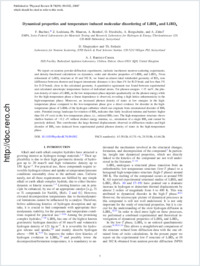Dynamical properties and temperature induced molecular disordering of LiBH₄ and LiBD₄
- Buchter, Florian EMPA, Swiss Federal Laboratories for Materials Testing and Research, Laboratory for Hydrogen & Energy, Dübendorf, Switzerland
- Łodziana, Z. EMPA, Swiss Federal Laboratories for Materials Testing and Research, Laboratory for Hydrogen & Energy, Dübendorf, Switzerland
- Mauron, Philippe EMPA, Swiss Federal Laboratories for Materials Testing and Research, Laboratory for Hydrogen & Energy, Dübendorf, Switzerland
- Remhof, A. EMPA, Swiss Federal Laboratories for Materials Testing and Research, Laboratory for Hydrogen & Energy, Dübendorf, Switzerland
- Friedrichs, O. EMPA, Swiss Federal Laboratories for Materials Testing and Research, Laboratory for Hydrogen & Energy, Dübendorf, Switzerland
- Borgschulte, A. EMPA, Swiss Federal Laboratories for Materials Testing and Research, Laboratory for Hydrogen & Energy, Dübendorf, Switzerland
- Züttel, Andreas EMPA, Swiss Federal Laboratories for Materials Testing and Research, Laboratory for Hydrogen & Energy, Dübendorf, Switzerland - Physics department, University of Fribourg, Switzerland
- Sheptyakov, D. Laboratory for Neutron Scattering, ETH Zurich & Paul Scherrer Institut, Villigen, Switzerland
- Strässle, Th. Laboratory for Neutron Scattering, ETH Zurich & Paul Scherrer Institut, Villigen, Switzerland
- Ramirez-Cuesta, A. J. ISIS Facility, Rutherford Appleton Laboratory, Chilton, Didcot, Oxon, United Kingdom
-
16.09.2008
Published in:
- Physical Review B. - 2008, vol. 78, no. 09, p. 094302
English
We report on neutron powder-diffraction experiments, inelastic incoherent neutron-scattering experiments, and density-functional calculations on dynamics, order and disorder properties of LiBH4 and LiBD4. From refinement of LiBD4 structure at 10 and 302 K, we found an almost ideal tetrahedral geometry of BD4 ions (difference between shortest and longest interatomic distances is less than 4% for B-D bond, and less than 3% for D-D bond), close to the calculated geometry. A quantitative agreement was found between experimental and calculated anisotropic temperature factors of individual atoms. For phonon energies <15 meV, the phonon density of states of LiBH4 in the low-temperature phase depends quadratically on the phonon energy while for the high-temperature phase a linear dependence is observed, revealing a high lattice anharmonicity in the high-temperature phase. Moreover, an increased phonon density of states at low energies in the high-temperature phase compared to the low-temperature phase give a direct evidence for disorder in the high-temperature phase of LiBH4 of the hydrogen sublattice which can originate from orientational disorder of BH4 units. Potential energy landscape for rotation of BH4 indicates that fairly localized minima and barriers higher than 0.6 eV exist in the low-temperature phase, i.e., ordered BH4 ions. The high-temperature structure shows shallow barriers of ~0.2 eV without distinct energy minima, i.e., orientation of a single BH4 unit cannot be precisely defined. This corroborates the large thermal displacements observed in diffraction studies and high disorder of BH4 ions deduced from experimental partial phonon density of states in the high-temperature phase.
- Faculty
- Faculté des sciences et de médecine
- Department
- Département de Physique
- Language
-
- English
- Classification
- Physics
- License
-
License undefined
- Identifiers
-
- RERO DOC 11400
- DOI 10.1103/PhysRevB.78.094302
- Persistent URL
- https://folia.unifr.ch/unifr/documents/301099
Statistics
Document views: 111
File downloads:
- pdf: 206
